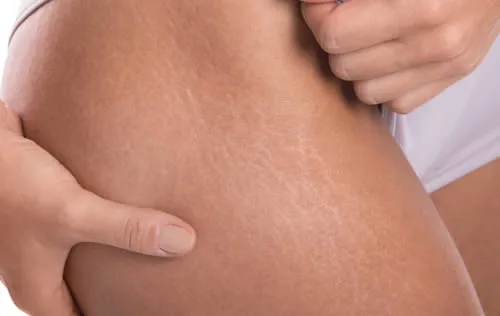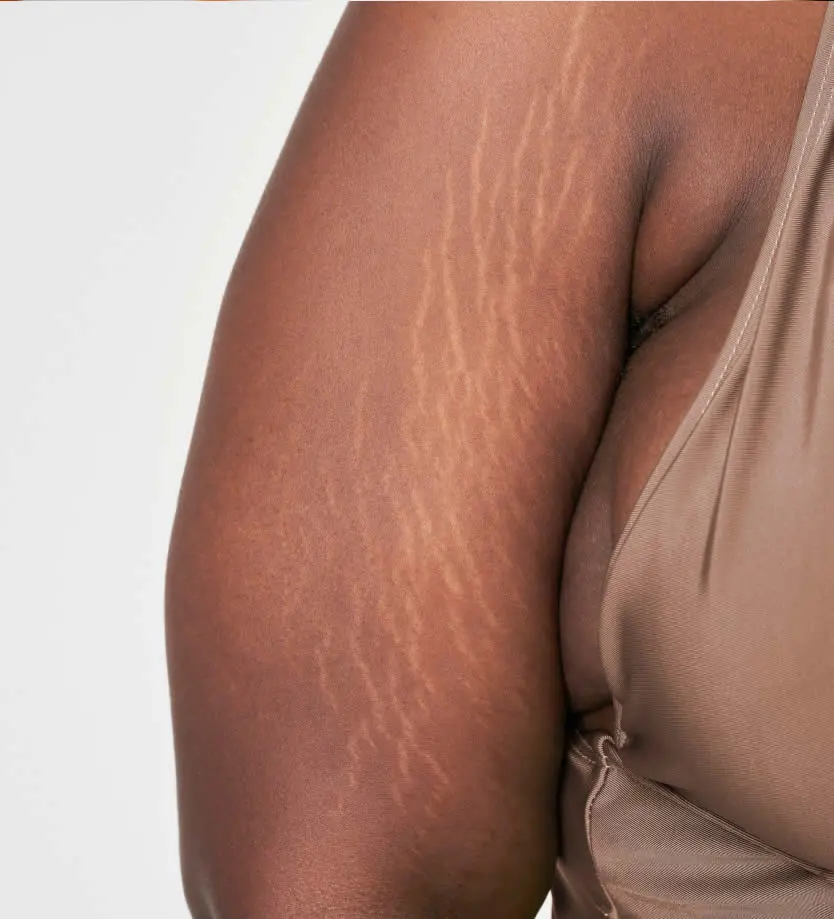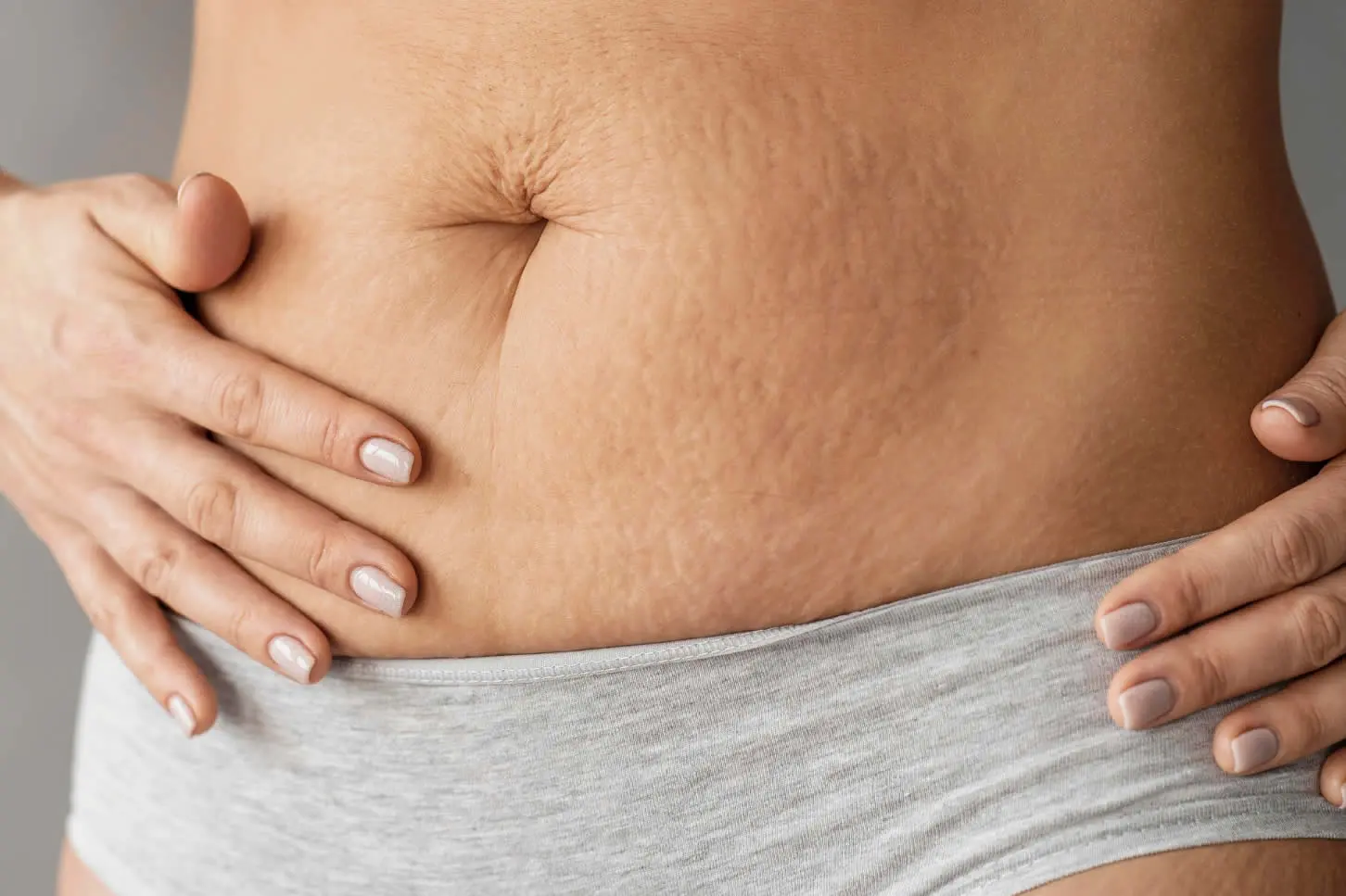What Are Stretch Marks?
Stretch marks are a common skin concern that many individuals experience at some point in their lives. These marks appear as streaks, lines, or bands on the skin and often have a different texture and color compared to the surrounding skin. Understanding what stretch marks are and why they occur can help shed light on this natural phenomenon.
Stretch marks are a form of scarring that develops when the skin undergoes rapid stretching or changes in size. They typically appear as slightly raised lines with a different hue than the normal skin tone. Initially, they might be red, pink, or even purple in color, and over time, they can fade to a lighter, silvery shade.

Causes and Risk Factors
Causes:
- Rapid Growth: One of the primary causes of stretch marks is rapid growth of the body. This can occur during periods of puberty, significant weight gain, or muscle building. As the skin is stretched beyond its normal capacity, the underlying connective tissue may become strained, leading to the formation of stretch marks.
- Pregnancy: Pregnant individuals often experience stretch marks due to the rapid expansion of the abdomen as the baby grows. Hormonal changes during pregnancy can also contribute to the development of stretch marks.
- Weight Fluctuations: Sudden weight changes, whether it’s gaining or losing weight, can impact the skin’s elasticity. This can result in the formation of stretch marks in areas like the abdomen, thighs, and hips.
- Genetics: Family history plays a role in determining whether an individual is more prone to developing stretch marks. If your parents or close relatives have had stretch marks, you might have a higher likelihood of experiencing them as well.
- Hormonal Changes: Hormonal imbalances, such as those associated with puberty, pregnancy, and certain medical conditions, can influence the skin’s ability to maintain its elasticity and resistance to stretching.
Risk Factors:
- Gender: While stretch marks can affect people of all genders, they are more commonly observed in females, especially during puberty, pregnancy, and after childbirth.
- Age: The younger the skin, the more elastic it tends to be. As we age, the skin’s natural elasticity decreases, making it more susceptible to stretch mark formation during periods of rapid growth or weight changes.
- Skin Type: Different skin types have varying levels of elasticity. Individuals with naturally drier skin may be more prone to developing stretch marks.
- Body Mass Index (BMI): People with a higher BMI may experience greater stretching of the skin due to increased weight, which can contribute to the development of stretch marks.
- Corticosteroid Use: Prolonged use of corticosteroid medications, either in topical or oral forms, can weaken the skin’s collagen and elastic fibers, making it more vulnerable to stretch marks.
- Medical Conditions: Certain medical conditions, such as Cushing’s syndrome and Marfan syndrome, can disrupt the body’s collagen production and increase the risk of stretch mark formation.
Types of Stretch Marks
- Red or Pink Stretch Marks (Striae Rubrae):
These stretch marks are characterized by their initial appearance as raised and reddish or pinkish streaks on the skin. They often occur during periods of rapid growth, such as puberty or pregnancy. Striae rubrae are indicative of recent skin stretching and are generally more responsive to treatment interventions. - White or Silvery Stretch Marks (Striae Albae):
As red or pink stretch marks mature over time, they tend to fade into white or silvery lines. Striae albae result from collagen and elastin breakdown in the skin’s middle layer, leaving the affected area with a more subdued color. While these stretch marks are older and less likely to be associated with active growth, they can still be addressed with suitable treatments. - Striae Associated with Pregnancy:
Pregnancy-related stretch marks often develop on the abdomen, breasts, hips, and thighs due to the rapid stretching of the skin. The hormonal changes during pregnancy can contribute to the formation of stretch marks. Addressing these marks requires specialized care tailored to the unique needs of expectant and postpartum mothers. - Weight-Related Striae:
Fluctuations in body weight, whether from weight gain or loss, can lead to the appearance of stretch marks. These marks often manifest on areas such as the abdomen, buttocks, and thighs. Effective treatment strategies focus on restoring the skin’s elasticity and minimizing the visible signs of weight-related stretch marks. - Genetic Predisposition:
Genetics plays a role in determining an individual’s susceptibility to developing stretch marks. If your family has a history of stretch marks, you might be more prone to experiencing them.
Non-Invasive Treatment Options
We offer effective non-invasive treatment options that can help improve the appearance of stretch marks.
Topical Creams and Lotions
Our dermatology experts may recommend topical creams and lotions designed to address stretch marks. These products can contain a combination of ingredients that help hydrate the skin, boost collagen production, and improve its elasticity. While over-the-counter options are available, our team can also provide prescription-strength solutions tailored to your unique needs.
Microdermabrasion
Microdermabrasion is a gentle and non-invasive procedure that involves exfoliating the outer layer of skin. This treatment can stimulate collagen production and promote the growth of healthier skin cells, which can lead to a reduction in the appearance of stretch marks.
Benefits of Non-Invasive Treatments
Choosing non-invasive treatment options for your stretch marks offers several advantages:
- Minimal Downtime: Unlike more invasive procedures, non-invasive treatments typically require little to no downtime, allowing you to resume your daily activities shortly after the session.
- Gradual Improvement: While results may vary, non-invasive treatments can lead to a gradual reduction in the appearance of stretch marks over time, helping you achieve a smoother skin texture.
Minimally Invasive Procedures
We offer a range of advanced minimally invasive procedures designed to effectively reduce the appearance of stretch marks and restore the beauty of your skin.
Laser Therapy:
Laser therapy is a popular choice for stretch mark reduction. By harnessing the power of laser technology, we can precisely target stretch marks, stimulating the production of collagen and elastin fibers within your skin. This process helps to improve skin texture, minimize the appearance of stretch marks, and promote overall skin rejuvenation. Laser therapy is safe, virtually painless, and requires minimal downtime, allowing you to return to your daily activities quickly.
Microneedling:
Microneedling is a gentle yet effective procedure that involves creating micro-injuries in the skin’s surface using fine needles. These micro-injuries trigger your body’s natural healing response, leading to increased collagen and elastin production. Over time, this process contributes to a reduction in the appearance of stretch marks and an improvement in skin texture. Microneedling is suitable for various skin types and is known for its minimal discomfort and brief recovery period.

FAQ About Stretch Marks Removal
Can Stretch Marks be completely removed?
Complete removal of Stretch Marks is difficult and often not possible. However, there are several treatments available that can help to reduce the appearance of stretch marks.
How long does it take to see results from Stretch Marks removal treatments?
The length of time it takes to see results from Stretch Marks removal treatments varies depending on the individual and the severity of the stretch marks. Some treatments may take several months to show results.
Are there any risks or side effects associated with Stretch Marks removal treatments?
Some treatments, such as laser therapy or chemical peels, may cause temporary redness, swelling, or discomfort. In rare cases, more serious side effects may occur. It’s important to discuss the risks and benefits of each treatment with a qualified medical professional.
Is there a dermatologist near me in Oceanside that offers Stretch Marks treatment?
Yes. At our Oceanside dermatology office we offer treatments for Stretch Marks to patients from Oceanside and the surrounding area. Contact our office today to schedule an appointment.

